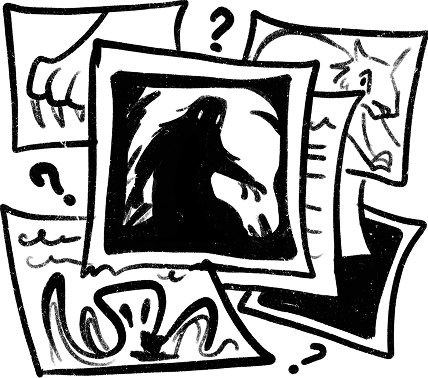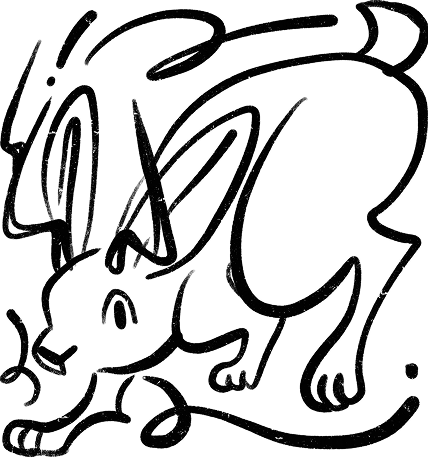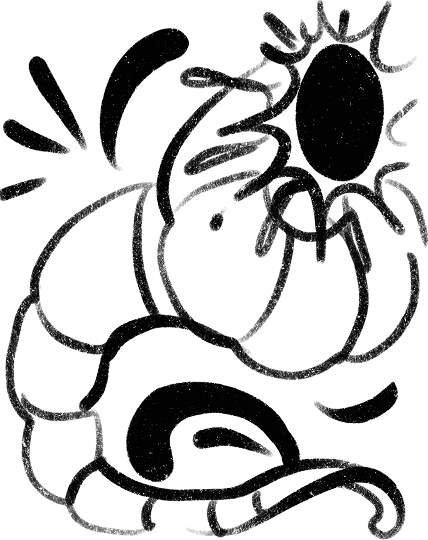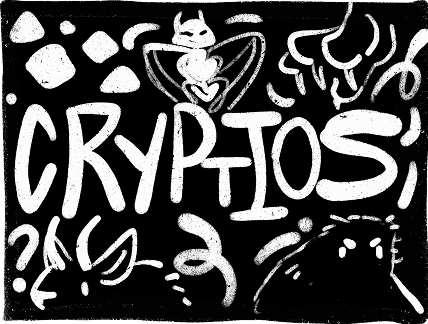Category: Cognitive technologies
Cryptozoology: the manifesto of the crypto community
“Cryptozoology is not a reliable science, or even a science at all. It is monster hunting”
Dan Ward, preface to The American Biology Teacher, 2011
To all who dare to uncover the truth: your eyes are blind, and your ears deaf to the reality that whispers under the veil of night, glides through the ocean depths, and hides in the impenetrable thickets. Science, blinded by pride, denies their existence—but they are among us. Their name is cryptids.
Cryptids are unidentified shadows on the borders of worlds, beings not written about in textbooks, whose traces are imprinted in the legends of all peoples. The Yeti roams the snowy wastelands, the Chupacabra drinks goat’s blood under the cover of night, Nessie breathes in the mists of an ancient lake, and the Kraken’s tentacles sink ships that dare to trespass into its domain. And these are just the few occasionally mentioned in worldly conversations. I dare say many of you have never even heard of the Stone Toad, the horned hares, or the Yesin! Yet they exist, wandering day and night across the earth, while you laugh and dismiss stories of their existence as myths and fairy tales.
But if cryptids are fiction, then where do entire expeditions vanish without a trace? To whom do the gigantic footprints found in mountains and rocky terrains belong? Why do hundreds of fishermen claim to have seen eyes in the depths of the waters that glowed in the dark and stared straight at them? Think about it.
We—the Fraternity of Cryptid Witnesses—know the truth. We have seen. We have heard. We warn. They are older than us. They are stronger. They do not want to be found. And one day, they will step out of the shadows—but are you ready to meet them? What will you say to the mythical monster whose existence you so confidently denied? And what is scarier: to live in ignorance or to know the terrifying truth that only a select few possess?
Witness, humans, and follow us. We will unveil all the secrets of cryptozoology and turn upside down everything you are used to. Science has fallen and no longer holds power over us. Cryptids stride confidently toward the rational mind, and only we know what to do about it.
Per Obscurum, Ad Veritatem Aeterna.
Fraternitas Testium Cryptidarum.
This World Is Far Stranger Than You Think
Cryptozoology is often dismissed as pseudoscience, but it is more accurate to classify it as a distinct subculture. People dedicate their lives to the study of cryptids—that is, animals whose existence is denied by official science. They study the natural habitats of unusual members of the fauna, visit scientific laboratories, library archives, museums, and galleries, speak with eyewitnesses, and search for any traces of “hidden beasts” in every corner of our vast planet. The main goal of cryptozoologists is to reconcile myth and reality, to prove that our world is far more astonishing than it might appear at first glance.

The first person to actively search for and study cryptids was the Franco-Belgian zoologist Bernard Heuvelmans. In 1955, he published the book In the Wake of Unknown Animals, the core ideas of which laid the foundation for the creation of the International Society of Cryptozoology. Today, the organization’s activities are suspended, but research in the field of cryptozoology continues to this day.
History records cases where rumors about cryptids became reality, forcing zoologists to acknowledge the existence of creatures they had previously dismissed. This was the case with the Komodo dragon—the first one was captured and killed by the Dutch colonial officer Stein van Hunsbruck in 1910 during an expedition to Komodo Island in Indonesia. The six-foot dragon turned out to be a giant Indonesian monitor lizard, and not the smallest one at that. Later, in 1926, American researcher William Douglas Burden captured two larger specimens and brought them to New York for further study.
A similar story occurred with the platypus—it was initially considered a fabrication of cryptozoologists. Yet, several years after the first encounters, research was conducted confirming that this remarkable animal truly exists. However, cryptozoology often confronts the harsh realities where so-called “mythical” animals turn out to be victims of natural mutations, genetic disorders, or the vivid imagination of particularly impressionable people.
Famous Cryptids in Their Natural Habitats
The Chupacabra—a four-legged monster from urban legends with smooth, hairless skin, an elongated snout, and sharp fangs—turned out to be nothing more than a common wild coyote. Coyotes often fall victim to mange mites, which causes them to lose their fur and gives them a frightening appearance. These predators primarily inhabit North and Central America, the very regions where the Chupacabra myths originated. Contrary to legend, the so-called “goat vampires” do not suck blood; they kill their prey on the spot simply because they are too weak to drag it into the forest.

The Yeti, Bigfoot, Snowman, or Sasquatch is also known by another name—Orang Pendek—and is a bipedal primate with human-like facial features. Its height ranges from 2.5 to 5 feet (approximately 1.5 meters), and its entire body is covered in thick golden-brown or white hair of considerable length. Orang Pendek prefers a solitary lifestyle and hides deep within the forests of Sumatra, making any encounter with it an almost impossible task.
According to sailors, the depths of the Antarctic waters are home to the ruthless Kraken—a monster capable of sinking any ship. In reality, the Kraken is a colossal squid. It is considered one of the largest invertebrates in the world, with lengths reaching up to 14 meters and a weight often approaching 500 kilograms. It is a passive predator, uninterested in ships, and incapable of sinking them, so there is no real reason to fear it.
According to legend, a large creature with a long neck and one or more humps protruding from the water has inhabited Scotland’s Loch Ness for centuries. It is called the Loch Ness Monster, or Nessie, and is surrounded by the most debate and mystery. The prevailing theory suggests that the famous Nessie is actually just a giant eel, whose DNA has been found in the waters of the famed lake. These eels can indeed reach several meters in length and resemble the mythical creature, but they rarely surface, never sticking their heads out of the water. As such, this theory has no official confirmation.
On Tastes There’s No Dispute
Can science exist without wonder? Hardly. People are drawn to anything that falls outside the boundaries of the familiar. Yet, unfortunately, sometimes “wonders” can become serious problems for our lesser brethren. Among the lesser-known representatives of “hidden animals,” the horned hare—or jackalope—is particularly intriguing. Witnesses and cryptozoologists describe it as a rabbit with small but quite solid and thick horns. And this is not entirely fictional. The jackalope does exist, but it is actually a common hare infected with Shope papillomavirus. This virus causes growths—dense, dark tumors on the head and body. They can grow in various directions and, from a distance, resemble horns and even a beard.

Most cryptozoologists are interested in large, unusual, and potentially dangerous creatures, which is why they actively search for evidence of the Stone Toad, Yesin, Olgoi-Khorkhoi, and the Mothman.
The Stone Toad was first described to people by Spanish conquistadors—according to them, this remarkable creature can, like a chameleon, blend in with rocks in mountains, forests, plains, and ruined cities. Such camouflage allows the toad to suddenly strike its prey with a sticky tongue and release paralyzing venom from its nostrils. Its victims could be any living creature, including humans. However, to date, humans have only encountered the Rock Toad—a completely harmless amphibian colored like wet stones, living on the highland plateaus of Argentina and classified as an endangered species.
Cryptids for the Chosen
Another favorite among cryptozoologists is the Olgoi-Khorkhoi. This creature is a mix between a massive earthworm and an electric eel. It reacts to ground vibrations from hooves, footsteps, or wheels, then kills all living things around it with an electric shock, rises from the earth, and makes itself a modest meal. Rumors of the Olgoi-Khorkhoi first appeared in Mongolia, and it later became the subject of numerous legends, films, and even books, such as Frank Herbert’s famous Dune. Some researchers suggest that the prototype of the Olgoi-Khorkhoi might be the Eastern sand boa—a species of snakes found from southern Mongolia to the Caspian Sea. Others believe it could be a legless reptile that lost its limbs through evolution and turned into a giant electric worm. Yet, there is still no definitive proof of this Mongolian cryptid.

For centuries, inhabitants of Myanmar have claimed that water elephants—Yesins—inhabit their rivers, a notion much beloved by cryptozoologists. Yesins rarely grow longer than a human hand but look remarkably like miniature elephants: they have ears, tusks, and trunks, though instead of hooves, they possess small feet with four flexible toes. Yesin tusks are venomous, instantly killing anyone who disturbs their peace. The people of Myanmar all believe in Yesins, and countless descriptions of the creature have been recorded by travelers over the past three centuries. Biologists suggest that the “water elephant” could be a rock hyrax, a tapir, or a coati, whose appearance vaguely resembles a miniature elephant. The venom, in turn, might come from water snakes that share the habitat with Yesins.
The cryptozoologists’ adventures do not end there. Another curious cryptid is the Mothman, a humanoid figure from urban legends in the USA, Italy, and Russia. The Mothman stands up to 4 meters tall, has no head, and sports bright red eyes on its chest. Wings grow from its back or sides, with a wingspan ranging from 3.5 to 6 meters. The humanoid rarely approaches humans, and only five verified sightings have been reported, often coinciding with natural disasters, fires, accidents, and mass deaths. Whether the Mothman truly exists or was mistaken for some unusual bird remains unknown.
While most cryptids have so-called “witnesses,” hidden creatures like the Popobawa and Kitovras were likely nothing more than artistic inventions from myths, legends, and fairy tales. Yet cryptozoologists pursue evidence of them too, because, as they say, it is impossible to invent something so extraordinary without ever having seen anything remotely similar in life. Could anyone conjure the image of a Kitovras—a creature with a horse’s body and a human head, better known as a centaur—if they had never seen one? And why did so many Tanzanians genuinely believe in the Popobawa, a malevolent dwarf spirit with a single eye in the forehead, small pointed ears, bat-like wings, and claws?
Most importantly, how could the image of such a monstrous being arise in the mind of the person who invented it?
Per Obscurum, Ad Veritatem Aeterna
Cryptozoology is a fascinating field of study. It searches for answers in places where official scientists refuse even to look. For some, it is a lifelong pursuit; for others, it is an intriguing adventure, a chance to witness something new and extraordinary. The true value of cryptozoology lies in its ability to make people question their knowledge of the world and to believe in wonders—even when everyone around them rolls their eyes and laughs. But what if that mysterious letter from the witnesses of cryptids turns out to be true?

Omne mysterium nihil nisi informationis inopia est…
We’ve discovered new laws of the Universe in your pocket. By the way, there are many forgotten things in the Universe too.
Thank you!




